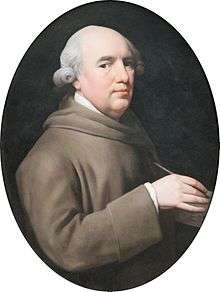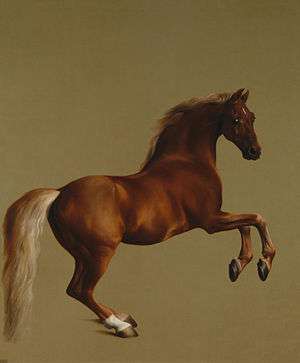George Stubbs
| George Stubbs | |
|---|---|
 A self-portrait by George Stubbs | |
| Born |
25 August 1724 Liverpool |
| Died |
10 July 1806 (aged 81) London |
| Occupation | British artist |
George Stubbs ARA (25 August 1724 – 10 July 1806) was an English painter, best known for his paintings of horses.
Biography
Stubbs was born in Liverpool, the son of a currier and leather merchant. Information on his life up to age thirty-five is sparse, relying almost entirely on notes made by fellow artist Ozias Humphry towards the end of Stubbs's life. Stubbs worked at his father's trade until he was 15 or 16.
After his father's death in 1741, Stubbs was briefly apprenticed to a Lancashire painter and engraver named Hamlet Winstanley, but he soon left as he objected to the work of copying to which he was set. Thereafter as an artist he was self-taught. In the 1740s he worked as a portrait painter in the North of England and from about 1745 to 1751 he studied human anatomy at York County Hospital. He had had a passion for anatomy from his childhood, and one of his earliest surviving works is a set of illustrations for a textbook on midwifery which was published in 1751.

In 1754 Stubbs visited Italy.[1] Forty years later he told Ozias Humphry that his motive for going to Italy was, "to convince himself that nature was and is always superior to art whether Greek or Roman, and having renewed this conviction he immediately resolved upon returning home". In 1756 he rented a farmhouse in the village of Horkstow, Lincolnshire, and spent 18 months dissecting horses, assisted by his common-law wife, Mary Spencer.[2] He moved to London in about 1759 and in 1766 published The anatomy of the Horse. The original drawings are now in the collection of the Royal Academy.
Even before his book was published, Stubbs's drawings were seen by leading aristocratic patrons, who recognised that his work was more accurate than that of earlier horse painters such as James Seymour, Peter Tillemans and John Wootton. In 1759 the 3rd Duke of Richmond commissioned three large pictures from him, and his career was soon secure. By 1763 he had produced works for several more dukes and other lords and was able to buy a house in Marylebone, a fashionable part of London, where he lived for the rest of his life.
His most famous work is probably Whistlejacket, a painting of a prancing horse commissioned by the 2nd Marquess of Rockingham, which is now in the National Gallery in London. This and two other paintings carried out for Rockingham break with convention in having plain backgrounds. Throughout the 1760s he produced a wide range of individual and group portraits of horses, sometimes accompanied by hounds. He often painted horses with their grooms, whom he always painted as individuals. Meanwhile, he also continued to accept commissions for portraits of people, including some group portraits. From 1761 to 1776 he exhibited at the Society of Artists of Great Britain, but in 1775 he switched his allegiance to the recently founded but already more prestigious Royal Academy of Arts.
Stubbs also painted more exotic animals including lions, tigers, giraffes, monkeys, and rhinoceroses, which he was able to observe in private menageries.
_NMM_ZBA5754_(cropped).jpg)
His painting of a kangaroo was the first glimpse of this animal for many 18th-century Britons.[3] He became preoccupied with the theme of a wild horse threatened by a lion and produced several variations on this theme. These and other works became well known at the time through engravings of Stubbs's work, which appeared in increasing numbers in the 1770s and 1780s.
Stubbs also painted historical pictures, but these are much less well regarded. From the late 1760s he produced some work on enamel. In the 1770s Josiah Wedgwood developed a new and larger type of enamel panel at Stubbs's request. Stubbs hoped to achieve commercial success with his paintings in enamel, but the venture left him in debt.[4] Also in the 1770s he painted single portraits of dogs for the first time, while also receiving an increasing number of commissions to paint hunts with their packs of hounds. He remained active into his old age. In the 1780s he produced a pastoral series called Haymakers and Reapers, and in the early 1790s he enjoyed the patronage of the Prince of Wales, whom he painted on horseback in 1791. His last project, begun in 1795, was A comparative anatomical exposition of the structure of the human body with that of a tiger and a common fowl, fifteen engravings from which appeared between 1804 and 1806. The project was left unfinished upon Stubbs's death at the age of 81 on 10 July 1806, in London.
Stubbs's son George Townly Stubbs was an engraver and printmaker.
The record price for a Stubbs painting was set by the sale at auction of Gimcrack on Newmarket Heath, with a Trainer, a Stable-Lad, and a Jockey (1765) at Christie's in London in July 2011 for £22.4 million. It was sold by the British Woolavington Collection of sporting art; the buyer was unidentified. [5]
The British Royal Collection holds 16 paintings by Stubbs.[6]
Two paintings by Stubbs were bought by the National Maritime Museum in Greenwich, London after a public appeal to raise the £1.5 million required.[7] The two paintings, The Kongouro from New Holland and Portrait of a Large Dog were both painted in 1772.[7] Depicting a kangaroo and a dingo respectively, they are the first depictions of Australian animals in Western art.[7]
List of selected artworks

- In the National Gallery, London
- Whistlejacket (1762)
- A Gentleman driving a Lady in a Phaeton (1787)
- The Milbanke and Melbourne Families (c.1769)
- The Kongouro from New Holland (1772)
- Portrait of a Large Dog (1772)
- In the National Museums Liverpool
- A Lion and Tiger (1779)
- A Monkey (1799)
- 'Gnawpost' and Two Other Colts (c.1793)
- Haycarting (1795)
- Haymakers (1794)
- Horse and Lioness (1775–1800)
- Horse Frightened by a Lion
- James Stanley (1755)
- 'Molly Long-Legs' with Her Jockey
- Self Portrait on a White Hunter (1782)
- The Farmer's Wife and the Raven (1782)
- In the Royal Collection
- "Pumpkin" with William South Up (c.1770–75)
- Sir Sidney Medows (1778)
- John Christian Santhague (1782)
- A Rough Dog (1790)
- A Bay Horse with a Groom (1791)
- John Gascoigne with a Bay Horse (1791)
- Portrait of a Gentleman (1791)
- Fino and Tiny (1791)
- Baronet with Samuel Chifney (1791)
- A Red Deer, a Buck and a Doe (1792)
- Soldiers of the 10th Light Dragoons (1793)
- William Anderson with two Saddle-Horses (1793)
- A Grey Horse (1793)
- A Grey Horse (1793)
- Laetitia, Lady Lade (1793)
- The Prince of Wales's Phaeton (1793)
- In the Tate Gallery
- A Grey Hunter with a Groom and a Greyhound at Creswell Crags (c.1762‑4)
- Horse Devoured by a Lion (exhibited 1763)
- Horse Frightened by a Lion (exhibited 1763)
- Mares and Foals in a River Landscape (c.1763‑8)
- Newmarket Heath, with a Rubbing-Down House (c.1765)
- Otho, with John Larkin up (1768)
- Horse Attacked by a Lion (1769)
- Mother and Child (1774)
- Horse in the Shade of a Wood (1780)
- Leopards at Play (1780)
- Portrait of a Young Gentleman Out Shooting (1781)
- Haymakers (1785)
- Reapers (1785)
- Bay Hunter by a Lake (1787)
- A Foxhound published (1788)
- A Foxhound Viewed from Behind published (1788)
- A Horse Attacked by a Lion (A Lion Devouring a Horse) (published 1788)
- A Lion Resting on a Rock published (1788)
- In other collections
- Hunterian Museum
- The Yak of Tartary (1791)
- Rhinoceros (1790–1792)
- Drill and Albino Baboon (before 1789)
- British Sporting Art Trust
- A Pointer (a pair)
- A Spaniel (a pair)
- Lord Clanbrassil with Hunter Mowbrary (1769)
- Fighting Stallions (1791)
- Goose with Outspread Wings
- Lions and a Lioness with a Rocky Background (1776)
See also
Notes
- ↑ The Great Artists: part 50: Stubbs. 1985. London: Marshall Cavendish Ltd. p. 1571.
- ↑ The Great Artists: part 50: Stubbs. 1985. London: Marshall Cavendish Ltd. p. 1572.
- ↑ The "i" newspaper, 21 June 2013. page 2
- ↑ The Great Artists: part 50: Stubbs. 1985. London: Marshall Cavendish Ltd. p. 1574.
- ↑ Scott Reyburn (6 July 2011). "Stubbs, Gainsborough Records Boost $80 Million Auction". Bloomberg.
- ↑ "Search results: George Stubbs (1724–1806)". Royal Collection.
- 1 2 3 "George Stubbs' kangaroo and dingo paintings to stay in UK". BBC News Online. 6 November 2013. Retrieved 6 November 2013.
References
Further reading
- Boyle, Frederick & Mayer, Joseph. Memoirs of Thomas Dodd, William Upcott, and George Stubbs, R.A. (Liverpool: D. Marples, 1879).
 Lee, Sidney (1885–1900). "Stubbs, George (1724–1806)". Dictionary of National Biography. London: Smith, Elder & Co.
Lee, Sidney (1885–1900). "Stubbs, George (1724–1806)". Dictionary of National Biography. London: Smith, Elder & Co. - Gilbey, Walter. Animal Painters of England from the Year 1650, Volume 2 (Vinton, 1900) p. 192 ff.
- Rump, Gerhard C. Pferde und Jagdbilder in der englischen Kunst. Studien zu George Stubbs und dem Genre der "Sporting Art" von 1650–1830 (Olms: Hildesheim, New York, 1983) ISBN 3-487-07425-7
- Egerton, Judy. George Stubbs, 1724–1806 (Tate Publishing Ltd, 1984).
- Morrison, Venetia. Art of George Stubbs (Headline Book Pub., 1989).
- Myrone, Martin. George Stubbs (British Artists series) (Tate Publishing, 2002).
External links
| Wikimedia Commons has media related to George Stubbs. |
- George Stubbs online (Artcyclopedia)
- George Stubbs – a celebration (Walker Art Gallery)
- George Stubbs (Encyclopedia of Irish and World Art)
- Paintings by George Stubbs (Tate Gallery)
- Profile on Royal Academy of Arts Collections
- Selected images from Anatomy of the Horse From The College of Physicians of Philadelphia Digital Library
